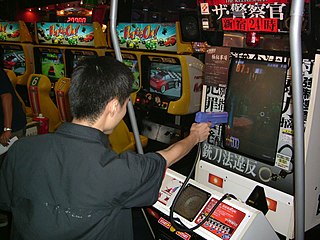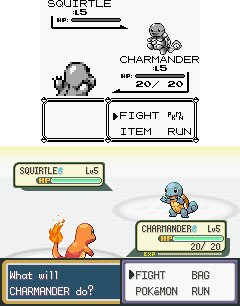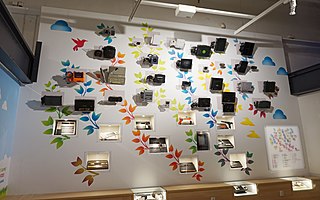Related Research Articles

The Atari 2600 is a home video game console developed and produced by Atari, Inc. Released in September 1977, it popularized microprocessor-based hardware and games stored on swappable ROM cartridges, a format first used with the Fairchild Channel F in 1976. Branded as the Atari Video Computer System from its release until November 1982, the VCS was bundled with two joystick controllers, a conjoined pair of paddle controllers, and a game cartridge—initially Combat and later Pac-Man.

The Atari 7800 ProSystem, or simply the Atari 7800, is a home video game console officially released by Atari Corporation in 1986 as the successor to both the Atari 2600 and Atari 5200. It can run almost all Atari 2600 cartridges, making it one of the first consoles with backward compatibility. It shipped with a different model of joystick from the 2600-standard CX40 and Pole Position II as the pack-in game. Most of the announced titles at launch were ports of 1981–83 arcade video games.

The Nintendo 64 (N64) is a home video game console developed by Nintendo. The successor to the Super Nintendo Entertainment System, it was released on June 23, 1996 in Japan; September 26, 1996 in North America; and on March 1, 1997 in Europe and Australia. It was the last major home console to use cartridges as its primary storage format until the Nintendo Switch in 2017. It competed primarily with the Sony PlayStation and the Sega Saturn.

The history of video games began in the 1950s and 1960s as computer scientists began designing simple games and simulations on minicomputers and mainframes. Spacewar! was developed by Massachusetts Institute of Technology (MIT) student hobbyists in 1962 as one of the first such games on a video display. The first consumer video game hardware was released in the early 1970s. The first home video game console is the Magnavox Odyssey, and the first arcade video games are Computer Space and Pong. After its home console conversions, numerous companies sprang up to capture Pong's success in both the arcade and the home by cloning the game, causing a series of boom and bust cycles due to oversaturation and lack of innovation.

A video game console is an electronic device that outputs a video signal or image to display a video game that can be played with a game controller. These may be home consoles, which are generally placed in a permanent location connected to a television or other display devices and controlled with a separate game controller, or handheld consoles, which include their own display unit and controller functions built into the unit and which can be played anywhere. Hybrid consoles combine elements of both home and handheld consoles.

Arcade video games takes player input from its controls, processes it through electrical or computerized components, and displays output to an electronic monitor or similar display. All arcade video games are coin-operated or accept other means of payment, housed in an arcade cabinet, and located in amusement arcades alongside other kinds of arcade games. Until the early 2000s, arcade video games were the largest and most technologically advanced segment of the video game industry.

A video game remake is a video game closely adapted from an earlier title, usually for the purpose of modernizing a game with updated graphics for newer hardware and gameplay for contemporary audiences. Typically, a remake of such game software shares essentially the same title, fundamental gameplay concepts, and core story elements of the original game, although some aspects of the original game may have been changed for the remake.
In the history of video games, the third generation of video game consoles, commonly referred to as the 8-bit era, began on July 15, 1983, with the Japanese release of two systems: Nintendo's Family Computer and Sega's SG-1000. When the Famicom was not released outside of Japan it was remodelled and marketed as the Nintendo Entertainment System (NES). This generation marked the end of the video game crash of 1983, and a shift in the dominance of home video game manufacturers from the United States to Japan. Handheld consoles were not a major part of this generation; the Game & Watch line from Nintendo and the Milton Bradley Microvision that were sold at the time are both considered part of the previous generation due to hardware typical of the second generation.

A home video game console is a video game console that is designed to be connected to a display device, such as a television, and an external power source as to play video games. Home consoles are generally less powerful and customizable than personal computers, designed to have advanced graphics abilities but limited memory and storage space to keep the units affordable. While initial consoles were dedicated units with only a few games fixed into the electronic circuits of the system, most consoles since support the use of swappable game media, either through game cartridges, optical discs, or through digital distribution to internal storage.

The Nintendo VS. System is an arcade system developed and produced by Nintendo from 1984 to 1990. It is based on most of the same hardware as the Family Computer (Famicom), later released as the Nintendo Entertainment System (NES). Most of its games are conversions from the Famicom and NES, some heavily altered for the arcade format, and some debuted on the VS. System before being released on the Famicom or NES. The system focuses on two-player cooperative play. It was released in three different configurations: upright VS. UniSystem cabinets, upright VS. DualSystem cabinets, and sit-down VS. DualSystem cabinets. Games are on pluggable circuit boards, allowing for each side to have a different game.
The history of video game consoles, both home and handheld, had their origins in the 1970s. The concept of home consoles used to play games on a television set was founded by the 1972 Magnavox Odyssey, first conceived by Ralph H. Baer in 1966. Handheld consoles bore out from electro-mechanical games that had used mechanical controls and light-emitting diodes (LED) as visual indicators. Handheld electronic games had replaced the mechanical controls with electronic and digital components, and with the introduction of Liquid-crystal display (LCD) to create video-like screens with programmable pixels, systems like the Microvision and the Game & Watch became the first handheld video game consoles, and fully realized by the Game Boy system.
Homebrew, when applied to video games, refers to games produced by hobbyists for proprietary video game consoles which are not intended to be user-programmable. The official documentation is often only available to licensed developers, and these systems may use storage formats that make distribution difficult, such as ROM cartridges or encrypted CD-ROMs. Many consoles have hardware restrictions to prevent unauthorized development. A non-professional developer for a system intended to be user-programmable, like the Commodore 64, is simply called a hobbyist.

The history of the Nintendo Entertainment System (NES) spans the 1982 development of the Family Computer, to the 1985 launch of the NES, to Nintendo's rise to global dominance based upon this platform throughout the late 1980s. The Family Computer or Famicom was developed in 1982 and launched in 1983 in Japan. Following the North American video game crash of 1983, the Famicom was adapted into the NES which was brazenly launched in North America in 1985. Transitioning the company from its arcade game history into this combined global 8-bit home video game console platform, the Famicom and NES continued to aggressively compete with the next-generation 16-bit consoles including the 1988 Sega Genesis. The platform was succeeded by the Super Famicom in 1990 and the Super Nintendo Entertainment System in 1991, but its support and production continued until 1995. Interest in the NES has been renewed by collectors and emulators, including Nintendo's own Virtual Console platform.
A dedicated console is a video game console that is limited to one or more built-in video game or games, and is not equipped for additional games that are distributed via ROM cartridges, discs, downloads or other digital media. Dedicated consoles were very popular in the first generation of video game consoles until they were gradually replaced by second-generation video game consoles that use ROM cartridges.

A ROM cartridge, usually referred to in context simply as a cartridge, cart, or card, is a replaceable part designed to be connected to a consumer electronics device such as a home computer, video game console or, to a lesser extent, electronic musical instruments.

A video game console emulator is a type of emulator that allows a computing device to emulate a video game console's hardware and play its games on the emulating platform. More often than not, emulators carry additional features that surpass the limitations of the original hardware, such as broader controller compatibility, timescale control, greater performance, clearer quality, easier access to memory modifications, one-click cheat codes, and unlocking of gameplay features. Emulators are also a useful tool in the development process of homebrew demos and the creation of new games for older, discontinued, or rare consoles.
Game development kits (GDK) are specialized hardware and software used to create commercial video games for game consoles. They may be partnered with game development tools, special game engine licenses, and other middleware to aid video game development. GDKs are typically not available to the public, and require game developers to enter an agreement, partnership, or program with the hardware manufacturer to gain access to the hardware. As console generations pass, development kits often get sold through websites like eBay without repercussions. This is often because the console manufacturers discontinue certain development programs as time passes.

An arcade video game is an arcade game where the player's inputs from the game's controllers are processed through electronic or computerized components and displayed to a video device, typically a monitor, all contained within an enclosed arcade cabinet. Arcade video games are often installed alongside other arcade games such as pinball and redemption games at amusement arcades. Up until the late 1990s, arcade video games were the largest and most technologically advanced sector of the video game industry.
In the video game industry, a console war describes the competition between two or more video game console manufacturers in trying to achieve better consumer sales through more advanced console technology, an improved selection of video games, and general marketing around their consoles. While console manufacturers are generally always trying to out-perform other manufacturers in sales, these console wars engage in more direct tactics to compare their offerings directly against their competitors or to disparage the competition in contrast to their own, and thus the marketing efforts have tended to escalate in back-and-forth pushes.

In the video game industry, the market for home video game consoles has frequently been segmented into generations, grouping consoles that are considered to have shared in a competitive marketspace. Since the first home consoles in 1972, there have been nine defined home console generations.
References
- ↑ "The Next Generation 1996 Lexicon A to Z". Next Generation . No. 15. Imagine Media. March 1996. p. 30.
- ↑ "The Next Generation 1996 Lexicon A to Z: Emulation". Next Generation . No. 15. Imagine Media. March 1996. p. 33.
- ↑ "The Replay Years: Our First Dynamic Decade In Words & Pix". RePlay. Vol. 11, no. 2. November 1985. pp. 120–32.
- ↑ Adlum, Eddie (November 1985). "The Replay Years: Reflections from Eddie Adlum". RePlay. Vol. 11, no. 2. pp. 134-175 (160-3).
- ↑ Kent, Steven L. (2001), The ultimate history of video games: from Pong to Pokémon and beyond : the story behind the craze that touched our lives and changed the world , Prima, p. 352, ISBN 0-7615-3643-4,
In 1982, Universal Sales made arcade history with a game called Mr Do! Instead of selling dedicated Mr Do! machines, Universal sold the game as a kit. The kit came with a customized control panel, a computer board with Mr Do! read-only memory (ROM) chips, stickers that could be placed on the side of stand-up arcade machines for art, and a plastic marquee. It was the first game ever sold as a conversion only. According to former Universal Sales western regional sales manager Joe Morici, the company sold approximately 30000 copies of the game in the United States alone.
- ↑ "Cover Story: "This Is the Good Time" – Capcom's CPS system brings success to the firm... and offers direction for a troubled video market". RePlay. Vol. 15, no. 7. RePlay Publishing. April 1990. pp. 183–5.
- ↑ Horowitz, Ken (July 30, 2020). "The Vs. System (1984)". Beyond Donkey Kong: A History of Nintendo Arcade Games. McFarland & Company. pp. 119–28. ISBN 978-1-4766-4176-8.